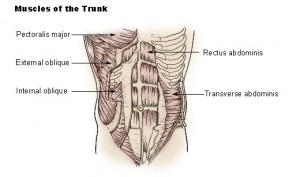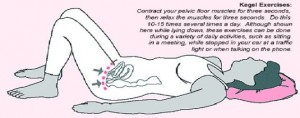This winter I have taken up the most balanced mix of running, cross-training, strength training and stretching as I ever have before. Probably because it’s just been too damn cold to run outside as often as I normally might. Nonetheless, I have found myself trying to nail some of the basics of building a strong core and pelvic floor.The root of this seems to be grounded in mastering the kegel, something I’ve tried before. After reading, and re-reading certain sections, of The Whole Body Fix in the current issue of RW I am feeling even more motivated to figure out this basic move and also kicking myself for not having been doing certain things all along (which will be the topic of a whole separate post).
Why the kegel? The kegel is an exercise that helps to strengthen the transverse abdominis (TA), essentially the lower abs. The lower abs are critical to overall stability, particularly through the hips and lower back all of which contribute to running form. This is really best described on the Runner’s Connect blog:
 “Contraction of the TVA compresses the chest cavity and increases its inner pressure, much like squeezing a deflated beach ball causes it to become stiff again. It’s postulated that this increase in pressure facilitates stability throughout the body, essentially “hardening” the connection between the upper and lower body.”
“Contraction of the TVA compresses the chest cavity and increases its inner pressure, much like squeezing a deflated beach ball causes it to become stiff again. It’s postulated that this increase in pressure facilitates stability throughout the body, essentially “hardening” the connection between the upper and lower body.”
I learned all too well the consequences of not having the proper strength and alignment throughout the pelvic and hip area during the Big Cottonwood Marathon so I really am trying to pay closer attention to how I can maintain a long-term pain-free running career.
How to Perform a Kegel Exercise
I don’t want to ruin the ending but now that I know how to do a kegel I am QUITE confident that I never did them right the first time. The best quick advice from my BFF pilates instructor is to engage the muscle you use when you make yourself stop peeing in midstream. I thought this is what I’d been doing. But then I read something about if when you relaxed you also felt other muscles relax, i.e., your glutes, then you were doing kegels wrong. Low and behold, every time I thought I was engaging my TAs, I would feel my glutes and even a little bit of my inner thighs relax all at the same time. Then I read the RW description in the current issue in the “Don’t Get Hurt” sidebar. Click here for the full column. I attempted following these instructions for a few days: Lying down, gently draw the two hip bones toward each other. It might have been working but I was definitely still using my glutes. Back to my BFF.
 How do you do a kegel?? She confirmed that if I was relaxing other muscles then, yes, I’m doing kegels wrong. She reminded me that what I’m really trying to work with is the muscle that’s used to stop a midstream pee. Then she said, sitting upright, find the very end of the tailbone so you know where that connects; keep your finger on it and try to pull it inward. That muscle contraction is the one and like everything else I’ve read, in theory, you should be able to do kegels anywhere once you’ve mastered the move.
How do you do a kegel?? She confirmed that if I was relaxing other muscles then, yes, I’m doing kegels wrong. She reminded me that what I’m really trying to work with is the muscle that’s used to stop a midstream pee. Then she said, sitting upright, find the very end of the tailbone so you know where that connects; keep your finger on it and try to pull it inward. That muscle contraction is the one and like everything else I’ve read, in theory, you should be able to do kegels anywhere once you’ve mastered the move.
I’m not sure I’ve mastered the kegel for sure but I’m pretty sure I’m finally doing it right most of the time. I can do it lying down. I can really only hold it for 5 seconds. My goal is to be able to hold for 10, 20, then 30 seconds and to be able to truly do kegels anywhere. More importantly, my goal is to keep doing them. Ideally I’ll do a few sets of kegels with each work-out for as long as I’m working out. And my pelvic floor will thank me.

In modern time, the Kegel exercises are good for both men and women. They works effectively.